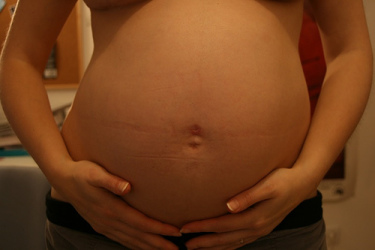
Sometimes if your baby is breech and can't be turned, or in some cases with twins, a caesarean tremendously lowers the risk to your baby.
If you and your health care adviser have decided that a C-Section is warranted for safety reasons, you'll be scheduling it. Obviously, you'll want to choose a care-giver who's very experienced with C-Sections and a hospital with an excellent record.
But are you aware that C-sections:
- Are major abdominal surgery with all the attendant pain and possible complications in the following weeks, just when you want to enjoy your new baby?
- Increase your risk of hemorrhage and infection?
- Result in a uterine scar and internal adhesions (scarring) that can cause pain and complications for years?
- Increase your chances of later ectopic pregnancy and difficulty conceiving?
- Increase your baby's chances of having asthma later in life?
- Delay your breastmilk coming in, making it so much more difficult to breastfeed that many women give up?
- Endanger the health of future pregnancies, increasing the chances of low birthweight, premature delivery and stillbirth?
- Often leave women with medical complaints six months or a year later?
If you really need a C-Section, they are a miraculous life-saver. If you don't, it's best to avoid it.
Luckily, most C-Sections are not actually medically necessary. 85% of all pregnancies are normal and low-risk, and absolutely do not warrant C-Sections. In fact, there is absolutely no medical evidence that a caesarean is necessary just because you had one last time, or because you're over 40. Even with a multiple birth a C-Section is often more dangerous than a vaginal birth.
Most importantly, do you know that you can tremendously reduce your risk of C-section by picking a care-giver who uses certain kinds of birth practices?
VBAC
(Vaginal birth after caesarean) If you had a C-Section last time, you can still have a Vaginal Birth this time. Do you know the most decisive factor in whether a woman can successfully have a VBAC ? Age. But not the age of the mom, or the term of the baby. The age of the doctor!
That's because doctors used to be educated with the misinformation that uterine rupture was more likely with a VBAC. But the New England Journal of Medicine published a landmark study in 2004 showing that uterine rupture occurs in less than 1% of VBACs. In other words, a woman who had a C-Section is just as likely to be able to have a healthy vaginal birth as any other woman.
Are you over 40?
It's true that women over 40 have a 40% chance of having C-Sections, and it is exhausting and demoralizing to struggle through a prolonged labor only to end up in the operating room having a C-Section. BUT did you know that you can hugely increase your chances of being part of the 60% of over-40 year olds who have normal vaginal births? That's right. Most women over 40 do not need a caesarean, and can avoid having one.
Avoiding a C-Section:
What every pregnant woman needs to know.
You can significantly reduce your chances of having a C-Section by informed choice of a caregiver and birth place. Here's how:
1. Exercise moderately during pregnancy.
Sedentary women are 4x as likely to deliver via caesarean section as women who did aerobics during the first or second trimester.
2. Find a caregiver who has a low C-Section rate
Find a caregiver who has a low C-Section rate and is experienced with successful VBACs. This is true even if you don't need a VBAC, because it means your caregiver doesn't default to caesareans.
3. Find a caregiver who will give you all the time you need
Find a caregiver who will give you all the time you need rather than rushing your delivery because of staffing issues.
4. Ask your caregiver what she does if your baby is in a breech position
Ask your caregiver what she does if your baby is in a breech position in late pregnancy. You want to hear that she is experienced with turning babies and always tries that before scheduling a C-Section.
5. Check Hospital policies.
If you're considering a VBAC, be sure to use a hospital that allows VBACs.
6. Arrange continuous trained labor support
Arrange continuous trained labor support which studies show keeps labor moving. If you aren't using a midwife, supplement your OB by hiring an experienced labor doula. A 2001 study in the journal of perinatal education showed a 56% reduction in the risk of caesarean in women receiving continuous one to one nursing/doula or midwifery care.
7. Be sure that your caregiver and birth venue encourage practices that support the normal process of labor and keep it moving:
- Arrange to stay upright and moving rather than lying down.
- Stay well-nourished and hydrated to give you energy
- Avoid continuous electronic fetal monitoring
- Avoid hastening labor with pitocin, which increases the severity of contractions and makes other medical interventions much more likely.
Check out Childbirth Connection, a fantastic resource for all aspects of birth and C-Sections, including VBACs and avoiding C-Sections.





